Black Holes: Harbingers of Death?
Separating the fact from fiction of black holes
Everything has a beginning and an end, just like the universe itself, which, according to the generally accepted theory, flung from the initial stage of a singularity, outwards in a process called the Big Bang.
In the Big Bang, the Universe rapidly expanded from the stage of singularity that led to the beginning of our universe. At the moment of creation, the universe was so hot that matter (which is normally composed of atoms) could not form, and it was only after some time, that subatomic particles—protons, neutrons, and electrons—could coalesce into hydrogen atoms and normal matter, that makes black holes today. The universe is 13.772 billion years old, according to the best estimate we have, but this is disputed right now thanks to a recent problem, called the Cosmic age problem, in which none of the data we have, agree about the actual age of the universe. (More about this in an upcoming post)
- Black Holes: What are they?
 |
| An artist's conception of a black hole Image credit: chandra.harvard.edu |
Black holes are spheres of highly compressed matter (neutron stars, white dwarfs, and massive blue stars) that possess infinite density in a finite amount of volume so that the escape velocity of the surface exceeds the speed of light. Since nothing can travel faster than light in our universe, according to General Relativity, nothing, not even light can escape the immense gravitational pull of a black hole if they get too close. Black holes can be spinning, or non-spinning.
Let us go through the various components of a black hole:
1. Event horizon- The Event Horizon of a black hole is the point of no return. It is a sort of horizon- a boundary past which all events, can no longer be observed by all observers outside a black hole. This is like the boundary of our universe; we cannot observe anything past it, as the universe is all there exists for us! So if you ever decide to take a trip to a black hole, make sure to not fall into the event horizon!
2. Singularity- All the mass of a black hole is concentrated in the center, a point of infinite density with zero volume, known as a singularity. In spinning black holes, the singularity is stretched into a ring singularity or ringularity- a ring of zero width, and hence zero volume, but infinite density. This is strikingly similar to the hot and dense singularity of our universe before the Big Bang.
3. Schwarzchild radius- The Schwarzschild radius is the smallest radius an object has to collapse into in order to become a black hole. It is a qualitative quantity, associated with all massive objects, and is given by the following equation, where
G = 6.67 * 10^-11 Nm2/kg2 (Universal Gravitational Constant)
c = 299,792,458 m/s (Speed of light in vacuum)
This implies that the Schwarzschild radius (Rg) is directly proportional to the Mass of the object (M); i.e.
This means that the more massive the object, the larger the Schwarzschild radius and the larger the volume to compress it into. This is why even the smallest black holes, (known as stellar-mass black holes) have to have at least the mass of 2-3 of our suns.
Fun fact: In order for the Earth to collapse into a black hole, all of its matter would have to collapse to the size of a peanut, and the Sun's mass into the size of the city of Manhattan. (Insert the values of M, G, and c into the equation and find out for both cases yourself)
4. Accretion disk- The accretion disk is a disk of diffuse material gravitationally bound to an active black hole. The matter in the accretion disk is not consumed by the black hole but remains in orbit around it. Only the innermost part of the circular accretion disk which comes closer than ISCO is eaten (See below) The matter in the accretion disks around black holes moves at such high velocities that Doppler shift becomes significant and matter starts emitting different energy photons in the Ultraviolet (X- rays, Gamma rays) or Infrared Spectrum (Microwaves and Radio waves)
5. Photon sphere- The photon sphere is an orbit, a spherical shell of light around a black hole. At this point in space, the light which is composed of photons can actually orbit a black hole. The slightest perturbations would make light fall into the black hole.
6. Ergosphere- The Ergosphere is a strange doughnut-shaped shell, present only around spinning black holes. It is a place where it is impossible to stand still, as the angular momentum of the black hole is dragging the curvature of spacetime with itself. Maybe one day, in the far future we could figure out a way to harvest this huge store of angular momentum for our own purposes and build a black hole civilization! That would be incredible to see 😉
7. Innermost Stable Circular Orbit (ISCO)- This is the sphere of all possible orbits close to a black hole that are stable, i.e. they don't lead to paths that converge in a black hole. The ISCO is different for different black holes with different spins (angular momentum values) Beyond the ISCO, all orbits decay into the black hole.
So now you can see that a black hole does not consume everything surrounding it wantonly. In order for something to be sucked in by a black hole, it has to come close to it, past the critical radius of the ISCO, after which it would inevitably be eaten by the black hole. This is why we aren't hanging around inside a black hole all the time, in case you were wondering. 😅
8. Relativistic jet- A relativistic jet is a gigantic outflow created by a supermassive black hole that is actively feeding on more matter than it can consume at once. The black hole is not repelling matter, it is just that too much matter tries to spiral down into the black hole than is possible. These jets often come in pairs and spew large amounts of hot and dense plasma outward.
- Black Holes: How do they come about?
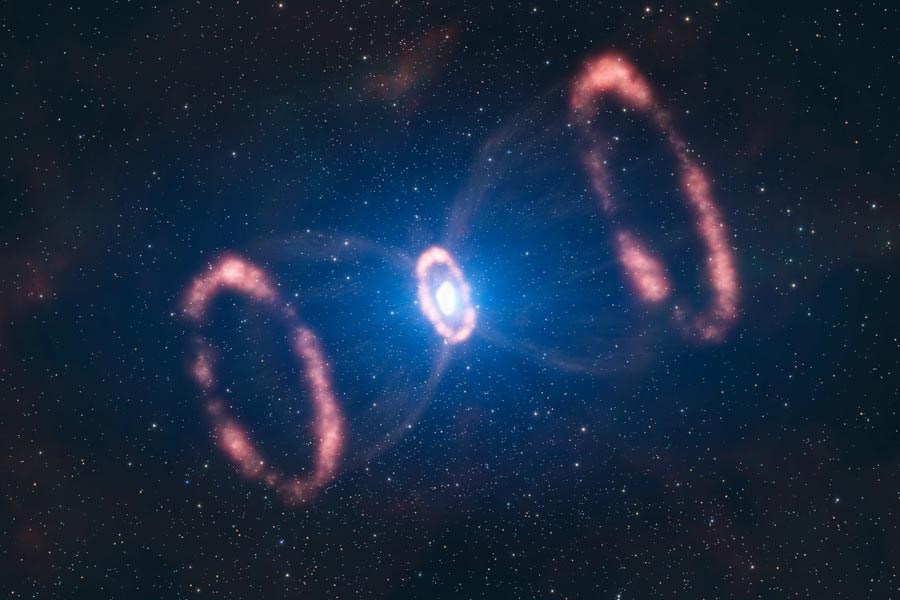 |
| An artist's conception of a Type II supernova Image credit: ESO/L Calçada |
Black holes have a very similar process of birth as the universe: when a massive object such as a blue giant star, a neutron star, or a white dwarf (at least about 2 to 3 solar masses M☉ ) collapses beyond its Schwarzchild radius, in a cataclysmic explosion called a Type II supernova, it then forms a black hole. a region of spacetime with infinite gravity, so that even light cannot escape it.
The reason I mentioned the Big Bang in this post, is not to talk about the eponymous television sitcom, but to highlight the striking similarity between the structure of a black hole and our own universe. Both of them possess a singularity and an event horizon. This is how the model of Black Hole Cosmology was born, in which the whole universe is a gigantic inescapable black hole. Note that it is just a model, a theory, but a really interesting one that I had to mention nevertheless.
- The flavors of black holes
Black holes come in 4 different flavors-
1. Supermassive black holes- These are black holes that have grown through mergers and by eating or accreting more matter from interstellar dust, gas, and stars. They have masses ranging from millions to even billions of solar masses and are usually present at the centers of galaxies. They can spaghettify large objects like stars and gas clouds, but not small objects, and instead, swallow them whole.
E.g. The black hole at the center of our galaxy- Sagittarius A* with 4 million solar masses, and the famous photographed black hole M87.
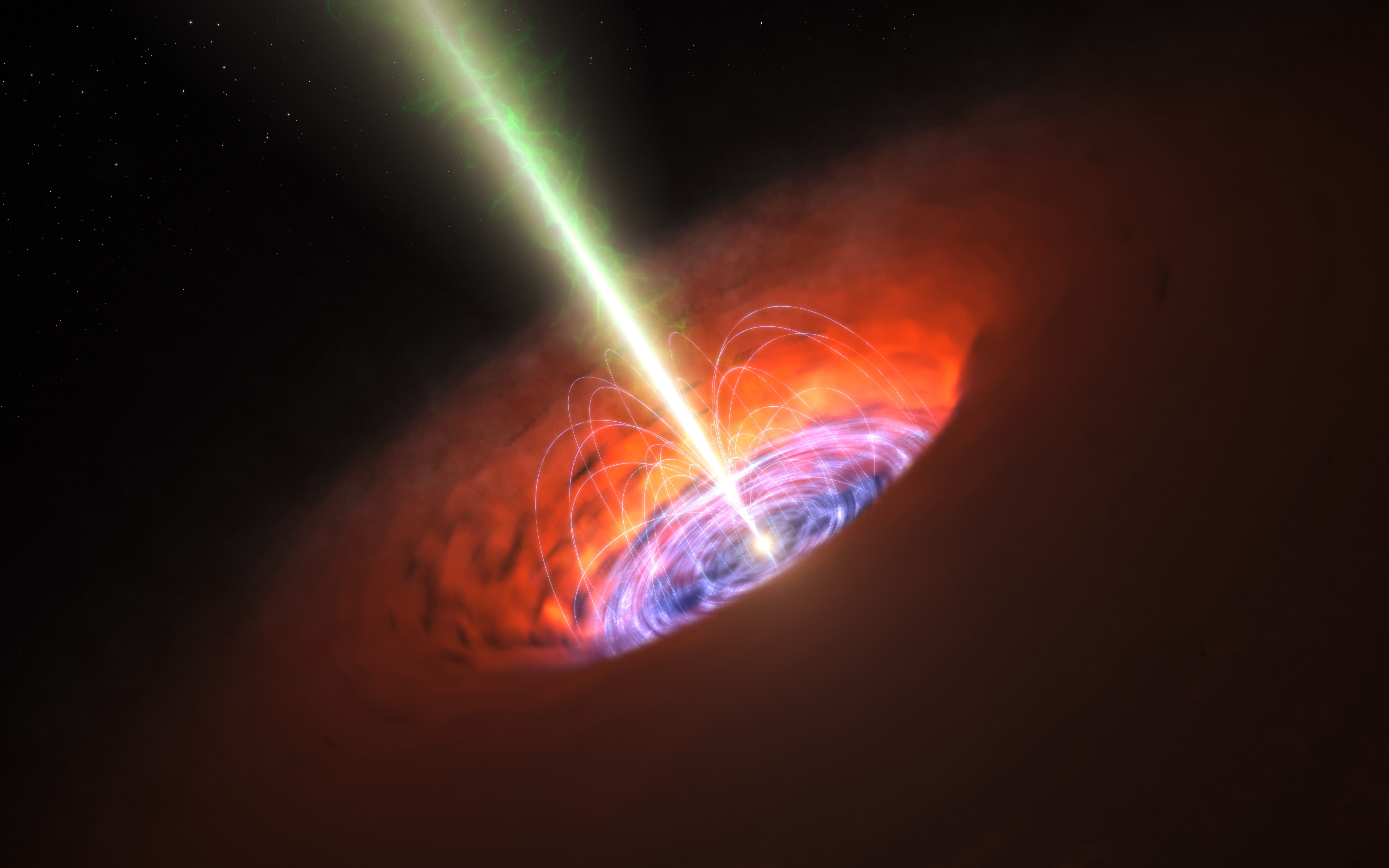 |
| An artist's conception of a supermassive black hole Image credit: www.wikipedia.org |
2. Stellar black holes- These are black holes that are smaller in size and have much less mass as compared to their bigger counterparts. They usually possess about 2-3 solar masses, the lowest for a black hole. They have not accreted a lot of matter yet. They spaghettify all the matter that enters them (spaghettification is stretching matter into really long strings, and this occurs due to strong tidal effects) instead of swallowing them whole, like their supermassive counterparts.
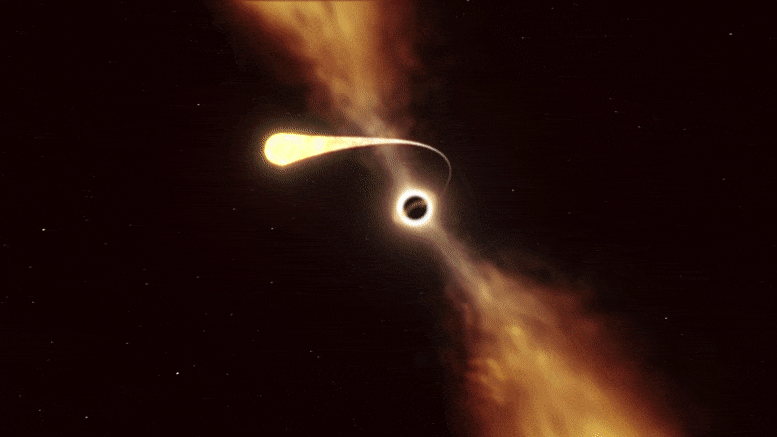 |
| An artist's conception of a black hole spaghettifying a star Image credit: scitechdaily.com |
3. Intermediate black holes- These black holes have a mass range that lies somewhere in between the supermassive and stellar black holes. They are rare.
4. Primordial black holes- These are hypothetical black holes that formed soon after the Big Bang. They are believed to have formed when the universe was not uniform but composed of different densities. The black holes formed in the areas with high densities and were sustained by their own gravity.
Black holes are like perfect black bodies, as they do not emit any radiation, and swallow all light and matter. This has led to some unanswered thermodynamical problems and the information paradox, (which asks, where do all the information stored in the matter and the matter itself go after they have been swallowed by a black hole?) which makes them incredibly fascinating and mysterious in my opinion.
- Quasars- Black holes can help galaxies shine!
There are objects known as quasars- galaxies, with huge supermassive black holes at their centers- which are a type of AGN (Active Galactic Nuclei) as the black holes inside them are actively feeding on surrounding matter so that gigantic outflows are created.
As the black holes in the AGN are actively feeding, there is a lot of gravitationally bound matter around them, which coalesces into a small space. Thus, the kinetic energy of the matter in the accretion disk steadily increases, and a lot of heat and light is produced.
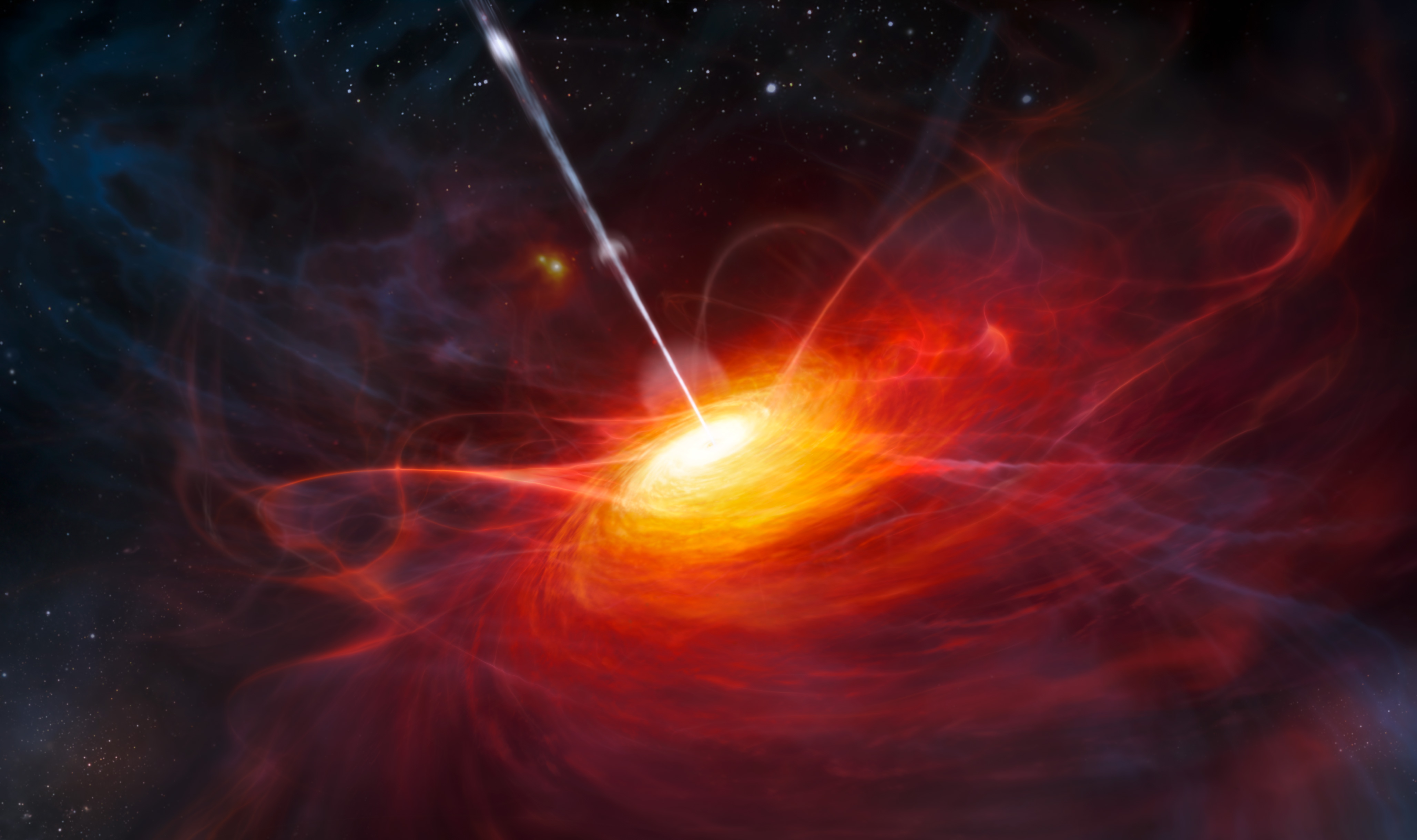 |
| Artist's conception of the quasar ULAS J1120+0641 Image credit: www.wikipedia.org |
Note that the light is being produced by the superheated plasma in the accretion disk and not by the black hole itself.
These accretion disks are incredibly bright, and often outshine their own galaxy. Unfortunately, quasars no longer populate the universe like they used to; they died out because there was not enough matter left in galaxies for the black holes to accrete. The Quasar era ended more than 10 billion years ago, shortly after the universe formed when a lot of matter was available.
Quasars were first discovered by Maarten Schmidt when he observed the farthest known object at the time, 3C 273, and noticed that its recession velocity was 16% the speed of light but was still incredibly luminous.
 |
| Quasar 3C273 taken by the Hubble Space Telescope Image credit: www.wikipedia.org |
- Death of black holes
The exact processes through which black holes die are uncertain. One theory, however, that of 'Hawking Radiation', put forward by the late theoretical physicist, Stephen Hawking attempt to explain how black holes die by "evaporating" into photons and other particles through a very slow process that takes 10^64 years for stellar-mass black holes, and more than a googol years for supermassive black holes.
This process lies in the realm of quantum physics, in which pairs of virtual particles that pop up due to various quantum fluctuations in a vacuum can exchange themselves for a real particle present just at the event horizon. This process inexorably leads to the black holes shedding their mass at a very slow rate.
- What is inside a black hole?
 |
| An artist's conception of a black hole Image credit: nasa.gov |
This is a question that unfortunately, we don't have an answer to at the moment.
Due to the fact that nothing can ever escape a black hole once it is sucked in, and that we cannot see what is inside a black hole as it doesn't emit any light, we don't have any visual way of knowing an answer to this question.
Our best bet then, is math and physics right? Yes, maybe. The problem is that black holes lead to some big mathematical and physical quandaries that are among the biggest unanswered questions, such as thermodynamical problems and the information paradox. Moreover, our math and physics seem to break down, when applied inside a black hole, leading to the popular belief that new math and physics need to be developed to unite General Relativity, Special Relativity, and the Standard Model in a grand "Theory of Everything", which would explain black holes.
Until then, we will just have to wait (sorry)
- The first image of a black hole!
Now for something exciting: the first image of a black hole was captured in the spring of 2020, and is the first photographic evidence proclaiming that black holes exist!
 |
| The photograph of the black hole in M87 Image credit: nasa.gov |
It was taken by the Event Horizon Telescope (EHT) which is the name given to the collection of radio telescopes and observatories around the world, which were pointed at the central supermassive black hole of M87, which is a staggering 55 million light-years away from us. The exposures were then combined so that the faint accretion disk of the black hole could be observed, and the boundary of its event horizon could be seen. The polarised version of the black hole image has been released, and it shows that the accretion disk is magnetized.
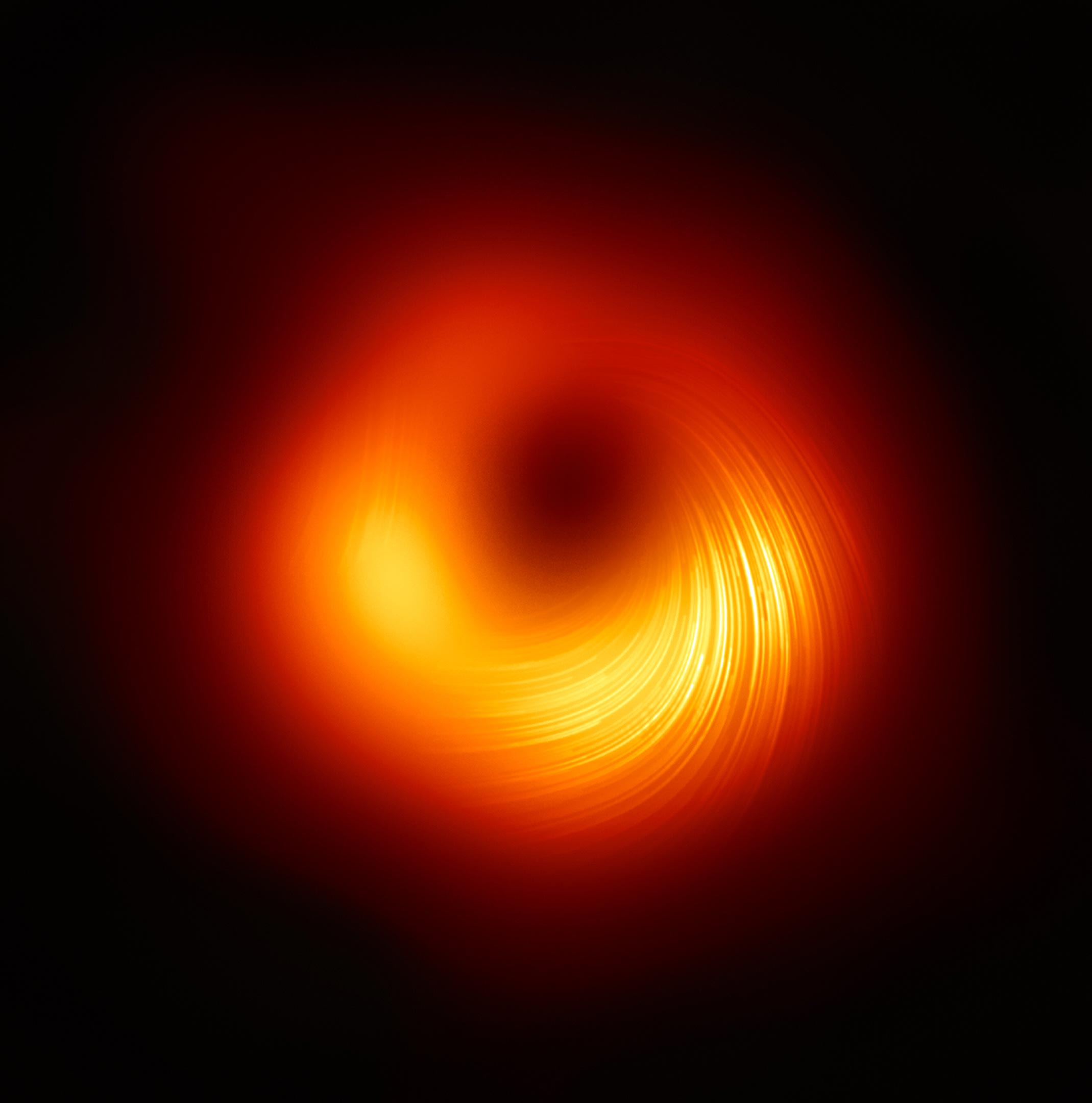 |
| Polarised image of the black hole in M87 Image credit: scitechdaily.com |
- The Nobel Prize for Physics (2020)
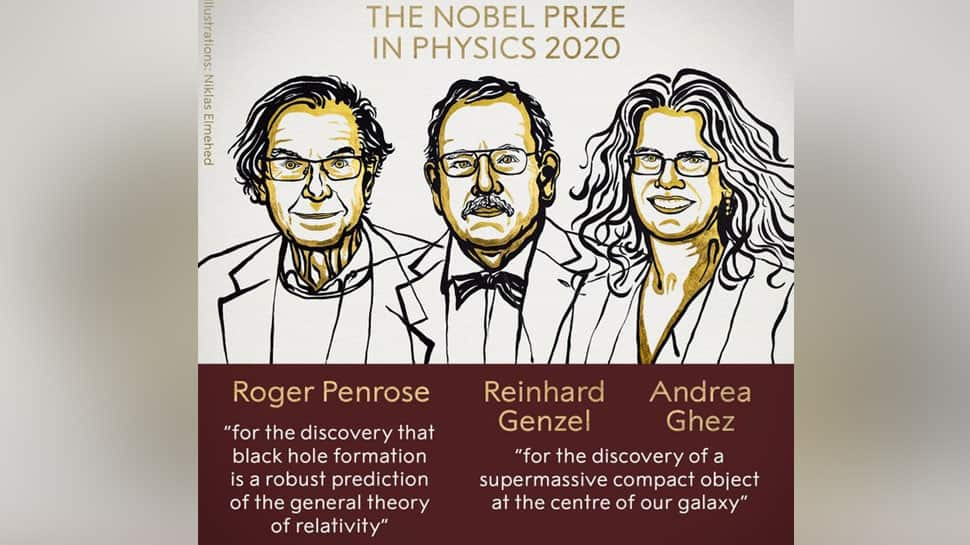 |
| Nobel prize for physics, 2020 Image credit: nobelprize.org |
The Nobel Prize for physics last year, 2020, had been awarded to three physicists- Sir Roger Penrose, for theoretical work on black holes and Reinhard Genzel and Dr. Andrea Ghez for their work on supermassive black holes at the center of the Milky Way galaxy. This is closely related to the first image of a supermassive black hole at the center of M87.
- Conclusion
So, to sum it all up, black holes are incredibly fascinating objects, with weird but wonderful mind-bending properties. But, more science needs to be done to discern the whole truth about them, as we are still uncertain about many of their properties.
What do you think of black holes?
 |
| A black hole warping the light of a galaxy behind it, in a phenomenon known as 'Gravitational Lensing' Image credit: www.wikipedia.org |




Hey Siya!!
ReplyDeleteIshita Here!
This was so helpful. Really simple for cause you know I am not as good in astronomy.
Thank you for posting this!
Keep up the great work!
Hi Ishita!
DeleteThank you for your comment! I am delighted that you found this post helpful!😄 I believe anybody and everybody can learn astronomy!
Look out for a post on the Sun- it's coming soon!